Abstract
The aim of this study was to investigate the shear performance of cross-laminated timber (CLT) and glulam made from densified Paraserianthes falcataria laminas. The densification process involved pre-treatment, compression with heat (105 °C, 6 MPa), and a cooling phase. CLT was manufactured from densified laminas of different thicknesses (24–60 mm), while glulam was produced from densified laminas that underwent pre-treatments of (1) pre-steaming (0–30 min) and (2) alkaline pre-treatment (sodium hydroxide (NaOH) concentrations: 0%–9%). Both CLT and glulam were cut into a pre-determined size before being subjected to a block shear test. The findings showed that the presence of pre-steaming (20 min) exhibited the highest shearing strength value. In contrast, alkaline pre-treatment reduced the shear performance of glulam. Here, 24 mm and 30 mm CLT were found to have the highest shearing strength among the parameters. Pre-steamed laminas showed better wettability, but no statistically significant correlation between the contact angle and shear strength of glulam. The densification process reduced the fiber pore areas of the laminas. The fiber pore areas with a shear strength of glulam, with or without alkaline pre-treatment, revealed a weak correlation. The correlation between fiber pore areas and the shear strength of CLT show no statistical significance. Here, 30 mm CLT with lowest moisture content and highest wood failure percentage exhibited a better bonding performance.
1. Introduction
Paraserianthes falcataria, or Batai, is one of Indonesia’s most important and adaptable tree species. Because of its strong growth rate, capacity to support life processes despite in a variety of soil types, helpful silvicultural characteristics, and cooperative qualitied wood for specific sectors, it is recommended for reforestation [1]. As a result of the fast-growing ability of P. falcataria, the wood material of this species tends to have a lower density, which is approximately 220 kg/m3 to 430 kg/m3 [1]. The low-density wood quality limits its applications, and it is only suitable for lightweight construction materials [2]. It is generally known that density is closely related to the mechanical properties of wood. An improvement in the density of wood could improve its performance mechanically.
One of the value-added technologies that have been widely studied by researchers over the past decades is the densification process. The densification process targets the increase in the density of wood by compressing the wood materials in between heated metal plates at a suitable temperature, time, and pressure. The original concept revolves around softening, compressing, setting, and fixing [3] the wood, which often results in reduced thickness. There are many densification processes that are available in the industry nowadays, some of which involve combination with chemical treatment to achieve their desired properties. The authors of [4] summarized the densification process, which involves mechanical modification into thermo-mechanic densification (TM), thermo-hygro-mechanic (THM), viscoelastic-thermalcompression (VTC), and thermo-vibro-mechanic (TVM). Historically, wood densification has been recognized and applied since the early 20th century. Products made from densified wood, such as Lignostone, were densified using a hydraulic press set to 140 °C and 25 MPa [5]. When birch veneer was densified by setting the pressure between 10 MPa and 17 MPa, it could achieve a density of up to 1300 kg/m3, which resulted in a product known as Staypak [4,5]. The densification process improved the properties of wood, where previous studies reported a remarkable increase in density of up to 172% [5,6,7]. Besides that, other properties such as the modulus of elasticity and modulus of rupture were enhanced by up to 44% and 55%, respectively [8,9].
Some of the past literature has discussed that the densification process that resulted in a smoother surface of wood was able to enhance the shear strength [10,11,12,13]. Arguably, some authors claimed that the smoother surface triggered a reduction in the shear strength of wood as the mechanical interlocking and adhesion surface were lesser, which were affected by the brittle cell wall structure after treatment [14,15]. Surface roughness tends to affect the bonding ability of wood. The authors of [16] suggested the possibility that over-smoothening a veneer surface during the densification process might be the cause of reducing surface adhesion, and would result in a lower value of tensile-shear strength. Tensile-shear strength is a measurement of the shear strength of an adhesive bond formed by two parts that are bonded together in a lap joint and that are tugged at both ends until the joint fails [16]. The tensile force divided by shear area is used to calculate the value of tensile-shear strength [16]. Furthermore, the authors of [17] stated that the surface characteristics and wetting capacity of wood are accounted for by the bonding quality. Therefore, investigation into the relationship between the shear strength and the wettability of wood (i.e., contact angle) could provide crucial information about the bonding ability.
Shearing resistance is one of the fundamental properties that need to be addressed during the mechanical performance evaluation of wood composite products. Densification has been proven [10] to increase the density of light hardwood, e.g., P. falcataria, as well as its mechanical strength, e.g., static bending and hardness. However, the information about the shear performance of this fast-growing timber species for glulam and CLT manufactured from densified wood materials is scarce. Therefore, this study aimed to investigate the shear performance of CLT, and glulam manufactured from densified wood material, treated using different approaches of pre-treatment (steaming and alkaline) prior to densification, was discussed thoroughly.
2. Materials and Methods
2.1. Raw Material Preparation
P. falcataria laminas with dimensions of 300 mm (length) × 50 mm (width) × 20 mm (thickness) were used for this study, where they were sawn from logs with an estimated rotation age of 7–9 years. The laminas were kiln-dried to achieve an equilibrium of 12% moisture content, followed by visual grading in order to distinguish laminas with a minimal number of defects such as knots and pinholes. Alkaline pre-treatment and steam treatment were performed on the laminas prior to the densification process.
2.1.1. Alkaline Pre-Treatment
Alkaline pre-treatment was done to reduce the lignin content in the wood cell wall. Lignin elimination from cell wall structures causes wood to become more porous and brittle. According to [18], it is hard to compress untreated woods because of the numerous microstructures in the wood cell wall. Different concentrations of sodium hydroxide (NaOH) with 3% (D3), 6% (D6), and 9% (D9) with 0% NaOH (D0) as a control were used to determine the effect of alkaline pre-treatment on the densification of low-density plantation timber in this study. Concentrations were prepared by referring to specified laboratory manual and previous literature [19]. Then, the densified laminas, with or without alkaline pre-treatment, were cut into small size test pieces with dimensions of 5 mm × 5 mm × 5 mm for scanning electron microscopy (SEM) examination according to the method in [11]. One test piece were obtained from both ends, and from the middle part of the laminas. The areas of the fiber pores were then determined based on the SEM images using ImageJ software version 1.52a from National Institutes of Health, USA.
2.1.2. Steam Pre-Treatment
P. falcataria laminas were pre-steamed following three different time durations (10, 20, and 30 min). The main purpose of pre-steaming, which was described by [20], was to soften the wood, which assisted the internal stresses relaxation during the densification treatment. Compression was conducted using a hot-press machine equipped with a cooling system, where the optimum compression settings were fixed using a pressing temperature of 105 °C and pressing pressure of 6 MPa. The target of thickness was set to 10 mm from the original thickness of 20 mm, through which the compression ratio was 50%. Pre-steamed/non-pre-steamed P. falcataria laminas were compressed with different settings, as shown in Table 1.

Table 1.
Different settings for viscoelastic-thermal compression (VTC) treatment.
Then, the contact angle measurement was performed to evaluate the wettability of the densified P. falcataria laminas, where polyvinyl acetate (PVAc) was used as the testing liquid. A total of 30 test pieces with dimensions of 50 mm (length) × 50 mm (width) × 10 mm (thickness) were prepared from each parameter based on previous studies [5,21].
2.1.3. No Pre-treatment
After conditioning at 20 °C, 65% relative humidity to achieve an average moisture content of 12%–15%, laminas underwent two-stage densification, using a hot-press machine at temperatures of 105 °C with 6 MPa for 10 min in each stage [8,9]. The venting phase (press release) was done (1 min 40 s) in between the two-stage densification to release the trapped moisture in the cell structures. Lastly, the laminas were cooled to below 100 °C while pressing to reduce the immediate spring back. Densified laminas of 8 mm, 10 mm, and 15 mm were produced through the usage of metal stoppers with these targeted thicknesses during pressing [12]. Figure 1 shows a diagram for the densification setup.
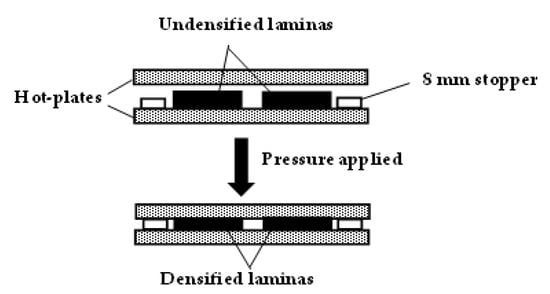
Figure 1.
Diagram of the densification setup.
Thirty replicates of test pieces with dimension of 5 mm × 5 mm × 5 mm were then obtained from densified and undensified laminas in order to determine the area of the fiber pores through SEM examination and ImageJ software, referring to [12].
2.2. Glulam and CLT Panel Manufacturing
All of the laminas were finger-jointed, edge, and face-glued using PVAc with 400 g/m2 glue spread. The densified alkaline pre-treated laminas (8 mm), steam pre-treated laminas (10 mm), and undensified (20 mm) laminas were arranged in a parallel direction to make three-layered glue-laminated timber (glulam) with dimensions of 300 mm (L) × 300 mm (W) × (24, 30, 60) mm (T). Six panels of glulam were produced for each parameter.
On the other hand, each layer of densified (8 mm, 10 mm, and 15 mm) and undensified/control (20 mm) laminas that did not undergo pre-treatment was laminated perpendicularly (90°) to the subsequent layer to produce a size of 300 mm (L) × 300 mm (W) × (24, 30, 45, 60) mm (T) three-layered CLT. CLT made from different thicknesses of laminas were labelled according to their total thicknesses, which were CLT 24, CLT 30, CLT 45, and CLT 60, in order to differentiate the test pieces produced [12]. Six panels were produced for each parameter of CLT as well.
2.3. Shear Strength Test
A total of 30 test pieces each, randomly selected from glulam and CLT, were subjected to block the shear test by referring to the Japanese Agricultural Standard for Glue-Laminated Timber (JAS Glulam) and British Standard (BS EN 16351), respectively [22,23]. For glulam, the dimensions of the test piece were set to 50 mm (L) × 50 mm (W) × 24/30/60 mm (T). As for CLT, test pieces with dimension of 50 mm (L) × 50 mm (W) with different thicknesses each were prepared. The test was performed using a shearing tool with an adjustable crossbar (Figure 2).
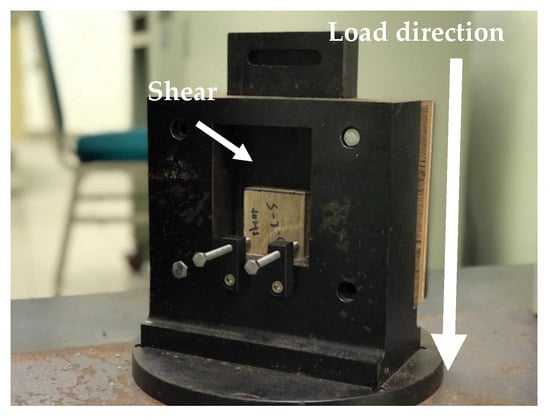
Figure 2.
Load application with adjustable seat to provide a uniform distribution of load.
For the glulam test piece, the load was applied continuously using an adjustable shear tool plate at 10 kN loading capacity and a test speed of 9800 N/min using a GOTECH Universal Testing Machine (UTM). The load was applied on the top lamina layer, which means the shearing load was fixated between the top and middle lamina layers of the respective glulam test piece. Each test was automatically stopped after the test piece reached the maximum shear load (N), and the shear strength was calculated using Equation (1).
The CLT test piece, on the other hand, was placed in the shearing tool with a fixture jig to hold the test piece, while the wood at one side of the glue line was loaded in the direction of the grain for layers, bonded orthogonally. The test speed of load applied was 1 mm/min with maximum load of 9300 kgf using UTM. The shear strength of CLT was also calculated based on Equation (1), in which the width and length of the test piece were accounted for as the area of shearing (Figure 3a). The wood failure percentage (%) was then identified to provide further information on the bonding performance of adhesive in CLT. The test piece was opened with hands to determine the wood failure according to ASTM D5266 [24]. Pictures of test pieces with damaged bonding surfaces were captured and areas of wood failure were measured using ImageJ software (Figure 3b). The wood failure percentage (WFP) was calculated based on Equation (2) [24].
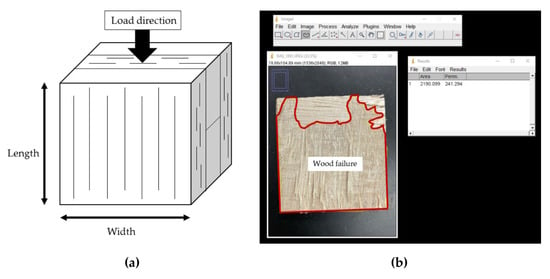
Figure 3.
Area of shearing (a) width and length of CLT test piece accountable for area of shearing. (b) Measurement of area of wood failure using ImageJ software.
2.4. Statistical Analysis
Data analysis was performed using one-way analysis of variance, where a post hoc least significance difference test was executed to determine the statistical differences (p ≤ 0.05) between the tested parameters (N = 30). Data collected for fiber pore areas and shear strength were from the laminas that underwent the same condition of the densification process (include pressing pressure, pressing temperature, pressing time, cooling stage, and conditioning). Therefore, a correlation analysis, such as fiber pore areas vs. shear strength of alkaline-treated densified glulam, contact angle of laminas vs. shear strength of steam-treated densified glulam, and fiber pore areas vs. shear strength of densified CLT at different thicknesses were also conducted using Pearson’s correlation, r.
3. Results and Discussion
3.1. Shear Strength of Alkaline-Treated Densified Glulam and Correlation with the Fiber Pore Area
Figure 4 shows the mean values of the shear strength, where D0 shows the highest mean value of shear in the untreated and densified P. falcataria glulam with 2.16 N/mm2, followed by D6 with 1.89 N/mm2 and D3 with 1.54 N/mm2. D3 has the lowest at 1.54 N/mm2. The R2 value for block shear was 0.0295.
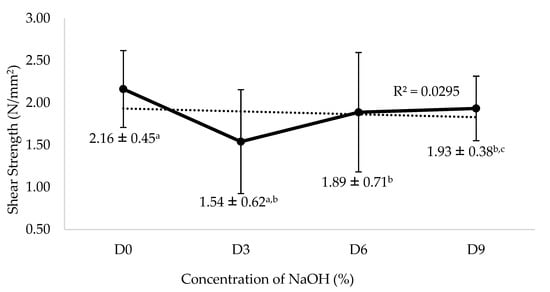
Figure 4.
Mean values and standard deviations of shear strength of untreated (D0) and alkaline treated (D3, D6, and D9) densified Paraserianthes falcataria glulam with different alphabets (a, b, c) indicating a significant difference at p ≤ 0.05.
According to the data of the fiber pore areas from [6], a coefficient correlation between the shear strength and fiber pore areas of untreated (D0) and treated (D3, D6, and D9) densified P. falcataria glulam were plotted, as shown in Figure 5. The relationship between shear strength and the fiber pore areas of D0 has been found to have a very weak negative linear correlation, with an r value of r(28) = −0.1, p < 0.61. This shows that the increase in the fiber pore area very weakly decreased the shear strength. However, the relationship between shear strength and fiber pore areas of D3, D6, and D9 showed a very weak positive linear correlation, with r values of r(28) = 0.06, p < 0.76; r(28) = 0.1, p < 0.60; r(28)= 0.02, p < 0.91. The results were statistically insignificant, where p-values were greater than 0.05.
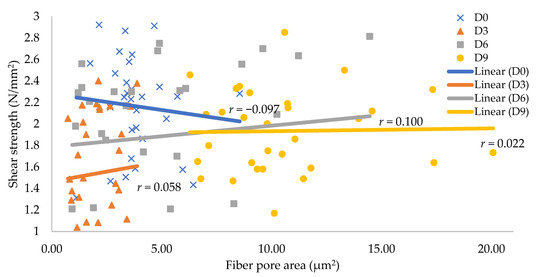
Figure 5.
Coefficient correlation between the shear strength and fiber pore areas of the untreated and treated Paraserianthes falcataria glulam.
Figure 6a–c shows the types of fractures after the block shear testing that occurred in the wood area for the glulam test piece, which mainly happened between the wood and glue. Failures that occurred at the glue–glue interface (Figure 6a) and wood–glue interface (Figure 6b) demonstrate the weak adherence of the glue and wood, while Figure 6c illustrates the strong adherence of the wood to the glue at the wood–wood interface. Alkaline pre-treatments degrade lignin. However, the whole process cannot be selective on lignin only, as cellulose and hemicellulose were also dissolved during treatment. This caused shortening of the cellulose chain and for the wood structure to be brittle. Therefore, compression causes small cracks in the wood structure and, as a result, the shear strength of the wood is reduced, which ultimately leads to a decrease in the shear strength of the glue-line [25]. The types of failures that occurred in the glulam test piece can be seen clearly in Figure 7a–c for D0, D3, and D9, respectively, as D6 has no splitting failure. The authors of [26] mentioned in their studies that the shear testing process was influenced by the adjustable shear tool and the person who handled the test. As in this study, there were high possibilities for failures that happened because of abnormal wood properties, shear tools, and wood adhesives, as reported in [27]. Other than that, the reduction in lignin content in wood after undergoing alkaline pretreatment also affected the result. D9 had the lowest lignin content for the treated lamina, while D0, untreated, had the highest lignin content, with about 45% differences in lignin content [6].
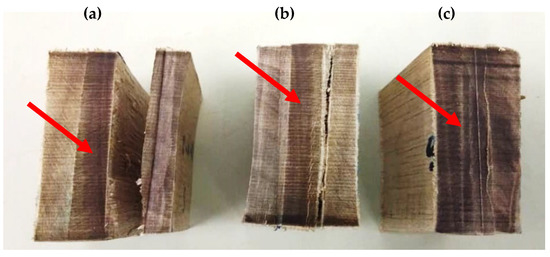
Figure 6.
Failure on shear; (a) glue–glue interface, (b) wood–glue interface, and (c) wood–wood interface.
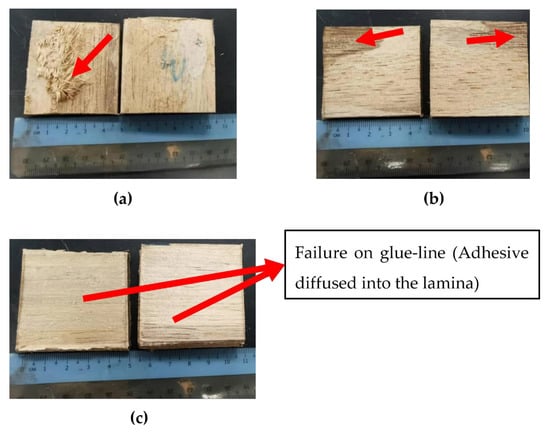
Figure 7.
Failures occurred in the (a) D0 glulam test piece, (b) D3 glulam test piece, and (c) D9 glulam test pieces.
3.2. Shear Strength of Glulam and Correlation with the Contact Angles
The shear strength test was carried out by referring to the Japanese Agricultural Standard for Glue-Laminated Timber [22]. The result, illustrated in Figure 8, indicates that S2/D obtained the highest mean value of shear strength (3.36 N/mm2), while the control (NS/ND) had the lowest mean value of 0.67 N/mm2. In terms of statistical differences, the control (NS/ND) had significant differences with all of the other parameters, while S2/D, NS/D, S1/D, and S3/D were not statistically dissimilar from each other. All of the laminas failed to comply with the minimum allowable shear strength set by [22], which was 5.4 N/mm2. The high shear strength value is dependent on the efficiency of the adhesive penetration inside the pores of the lamina layers [28].
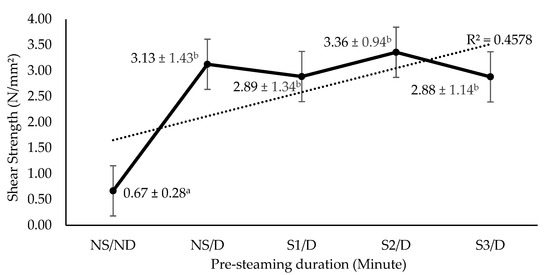
Figure 8.
Mean and standard deviation with letters (a, b) indicating significant different (p ≤ 0.05) for shear strength of glue-laminated timber manufactured from densified Paraserianthes falcataria laminas.
Densified glue-laminated timbers were found to have a better bonding quality compared with the untreated one, whereby poor wettability (i.e., higher contact angle) of the control (NS/ND) resulted in inefficient penetration of the adhesive inside the capillary of the lamina layers, thus causing it to have a low shear strength. Nevertheless, the findings contradicted a previous study by [6] reported that non-densified laminas had better wettability characteristics than the densified samples because of the high porosity in the wood samples. This means that the control (NS/ND) should have a better bonding quality as it was not subjected to densification treatment, where cell lumens and fiber pores were not collapsed and were highly porous.
Another study on the mechanical strength of densified wood by [29] reported that the undensified samples had a lower shear strength than the densified ones. The author stated that the increase in the density of densified samples enhanced their resistance against shear strength, although they had a poorer wettability than the undensified ones [29]. The inconsistency between the results obtained from this test and those obtained from previous literature sources could have been influenced by the selection of random wood zones with varying extractive contents and wetting characteristics as samples [30,31]. Morever, an earlier study on the density of P. falcataria logs by [32] discovered that the density of this particular species increased from the pith to the outer region of the log. The author also suggested that the difference in density values could be affected by the variation of extractive content in the core and outer parts of the logs [32]. These previous findings might justify the irregularity in the result, where it can be suggested that the control parameter possessed a high extractive content, thus causing it to have poor wettability, which led to the lowest shearing strength mean value. Besides that, the density of control (NS/ND) was lower than the densified glue-laminated timbers, as stated in a previous study on the density of densified P. falcataria by [5]. A reduction in density, mechanical strength, and wettability produced a low bonding strength [33]. This justifies why the control (NS/ND) produced a low shear strength, due to its low density. Moreover, manual glue spread error during the gluing process might influence the outcome of this test. There might be an uneven distribution of adhesive, as the process was conducted manually.
The result displayed in Figure 9 indicates that the control (NS/ND) had a poor wettability, while S1/D was revealed to have an excellent wettability. On the 30th second, the control (NS/ND) continued to have the highest contact angle mean value of 96.73°, while S1/D obtained the lowest value (74.72°). S3/D statistically differed from all other parameters. S2/D and S1/D were not statistically different from each other. On the other hand, NS/D had statistical difference with the control.

Figure 9.
Contact angles for densified Paraserianthes falcataria laminas.
Previous studies have stated that water is less viscous when compared with polyvinyl acetate (PVAc), which both have 0.001 Pa·s and 3.039 Pa·s viscosity value at room temperature, respectively [34]. This statement explains why polyvinyl acetate (PVAc) required a more extended period to be fully diffused inside the substrate (wood), while water only took about ≤30 s to be penetrated entirely inside the wood [5]. Moreover, [35] briefly explained that encrusted pits in heartwood decreased water permeability inside the wood, thus making heartwood have a lower liquid penetration rate than sapwood, which explained why some of the samples had a higher contact angle compared with others.
However, a previous study on the contact angles and wettability characteristics of different wood species published by [36] stated that no significant differences were found between the heartwood and sapwood of Douglas-fir and Pine. Nevertheless, they suggested that different wood species might contain heartwood and sapwood that varied in wetting properties, and the extractive content can influence the wettability properties of particular wood zones [36].
The correlation analysis carried out to investigate the association between the shearing strength of glue-laminated timber and the contact angle (PVAc), density profile (lamina and glue-laminated timber) showed that none of the relationships were statistically significant, where the p-values were greater than 0.05. The results are shown in Figure 10.
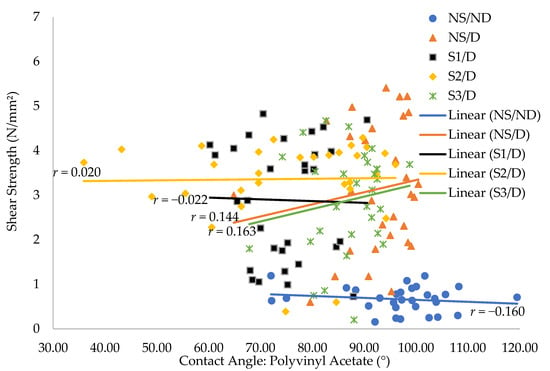
Figure 10.
Correlation between shearing strength of glue-laminated timbers and contact angles (polyvinyl acetate) for laminas.
3.3. Shear Strength of CLT and Correlation with the Fiber Pore Areas
The shear test of CLT in this study was important in order to determine the bonding strength and integrity between adhesives and laminas that had undergone densification. Figure 11 shows that both CLT 24 and CLT 30 had a similar average shear strength value of 1.65 N/mm2, which showed no statistical significance (p > 0.05). Moreover, CLT 60 (control), which was manufactured from undensified (20 mm) laminas, had the lowest shear strength value, which was 1.43 N/mm2.
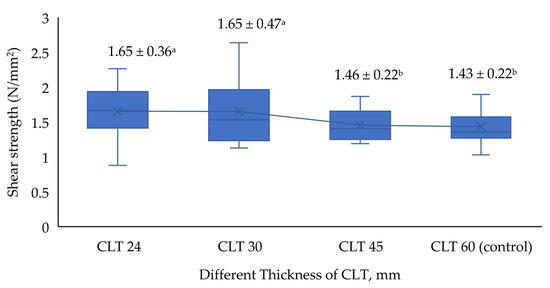
Figure 11.
Mean and standard deviation of shear strength with different letters (a, b) for different targeted thicknesses of CLT (CLT 24, CLT 30, CLT 45, and CLT 60) indicate significant differences at p ≤ 0.05.
However, in Figure 11, CLT 24 had the highest median shear strength value, which was 1.67 N/mm2. Subsequently, CLT 30 recorded a median shear strength value of 1.53 N/mm2, followed by 1.4 N/mm2 for CLT 45, while CLT 60 had the lowest median shear strength value of 1.35 N/mm2. The shear strength of CLT also decreased with the increasing total thickness of CLT panels. The result in this study revealed that the thermal-densification process of laminas resulted in better shear strength compared with the undensified lamina (Figure 11). The shear strength values of CLT from the densified laminas were consistent with the authors of [11], who found that the shear strength of the laminated veneer lumber bonded with PVAc adhesive fell below 2.0 MPa.
There was no statistical significance (p > 0.05) between CLT 45 and CLT 60, indicating that CLT produced from surface-densified laminas (15 mm) had no significant effect on the shear strength compared with the control (CLT 60). As the laminas densified further to CLT 30 (CR 50%) and CLT 24 (CR 60%), most of the void spaces in the cell structure were reduced (bulk densification). The shear strength of CLT 24 and CLT 30 were then significantly improved (p ≤ 0.05) compared with CLT 45 and CLT 60 that were manufactured from surface-densified (15 mm) and undensified (20 mm) laminas. However, CLT 30 showed a wider boxplot, which indicates a larger spread of data range (Figure 11). The maximum value could reach up to 2.27 N/mm2. Wood failure (%) could provide a further explanation of this.
The wood failure (%) after shear strength test was often used to measure and assess the bonding performance of the adhesive for CLT. Because of the extreme values in the large dispersion sets of data for wood failures percentage, median values of wood failures from split surfaces were used to assess the results (Table 2).

Table 2.
Wood failure percentages of CLT manufactured from densified and undensified laminas under shear.
Accordingly, CLT 30 had the highest median value of wood failure, which was 96.67%, which indicated a better bonding performance for the wood-–adhesive interface. This might be associated with the lower MC of CLT 30 (10 mm densified laminas). Lower MC is often accompanied by better strength properties. As MC lowered, there was less shrinking and swelling of the laminas due to the surrounding humidity, which affected the bonding ability. However, only CLT 45 recorded the lowest median value of wood failure below 80%. Such a phenomenon might be associated with the surface densification of 15 mm laminas, in which some of the pores had closed and restricted the glue penetration into the cell structures for adhesion.
Based on the results for the fiber pore area obtained from [7], a correlation graph between the effect of the fiber pore area in laminas (densified and undensified) and the shear strength of CLT manufactured from these laminas was plotted, as shown in Figure 12. The linear regression in the figure provides the implication that a correlation exists between the fiber pore area in densified laminas (10 mm and 15 mm) and the shear strength of CLT manufactured from CLT 30 and CLT 45.
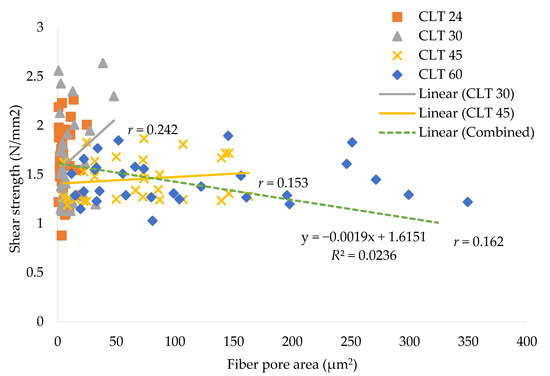
Figure 12.
Correlation between the morphology (fiber pore area) of densified and undensified laminas with a shear strength of CLT panels manufactured from the laminas.
The fiber pore area for 10 mm densified laminas showed a positively weak correlation (r = 0.242) with the shear strength of CLT 30. On the other hand, the area of pores (15 mm densified laminas) also gave a positively weak correlation (r = 0.153) with a shear strength of CLT 45. This might be due to the variability of different sized fiber pore areas (some were reduced while some are not) in both laminas densified to 10 mm and 15 mm thick. However, it is important to note that the shear strength of CLT showed a negative weak correlation (r = −0.162) with the fiber pore areas when all thicknesses (8 mm, 10 mm, 15 mm, and 20 mm) of laminas were taken into account (N = 120, Figure 12). This finding was similar to the study by [37]. Nonetheless, there were no statistically significant differences detected between the fiber pore areas and shear strength of CLT at which the p-values were greater than 0.05. Notably, the amount of adhesive spread might be accountable for the bonding strength in this study. The amount of adhesive spread (400 g/m2) used in this study was constant for different thicknesses of CLT. Therefore, it can be concluded that the adhesive spread of 400 g/m2 might be optimum for CLT 30 (10 mm densified laminas), as it resulted in a higher shear strength (maximum value 2.27 N/mm2) with higher wood failure percentage (96.67%). The partially collapsed pores of 10 mm densified laminas enabled the adhesive to penetrate the laminas, as well as creating a sufficient bondline on the surfaces.
This is important as if too much adhesive penetrates into more porous (20 mm undensified) laminas, insufficient adhesive on the bondline will cause less adhesion in between the surfaces of the laminas. However, the penetration of an adhesive into less porous/smoother (8 mm densified) laminas tends to form a layer of adhesive film that sits on the surface of the laminas, which does not provide a strong lamina–adhesive interaction. This theory agrees with [8], who manufactured plywood using Densified Birch vs. Black Alder. Generally, different species with different compatible adhesives are one of the factors affecting the bonding strength of wood surfaces [12,38].
4. Conclusions
In conclusion, the shear strength for glulam made from alkaline pre-treated laminas (D3, D6, and D9) showed a decrease in mean values and were all weaker than the untreated densified glulam (D0). There was a weak correlation between fiber pore areas with the shear strength of glulam, with or without alkaline pre-treatment.
As for the pre-steam treatment, no statistical difference was found between non-pre-steamed and pre-steamed parameters of densified laminas. Although the contact angle values of pre-steamed laminas showed better wettability, the correlation analysis carried out showed that the relationships between contact angle and shear strength were insignificant in all parameters.
However, the densification of laminas significantly improved the shear strength of CLT. The reduction in thickness of CLT pushed the improvement of shear strength, with the highest value (1.65 N/mm2) obtained in CLT 24 and CLT 30. Nonetheless, the correlation analysis revealed that the fiber pore areas did not have a significant effect on the shear strength of CLT. Based on the result of the wood failure percentage, CLT 30 had a better bonding performance (wood failure percentage—96.67%), at which a lower moisture content was detected.
The shear strength process was influenced by the adjustable shear tool and the person who handled the test. Other than that, there were high possibilities that the failures happened because of the difference in wood properties, shear tools, and wood adhesives. Further study can be carried out to investigate the different spread of adhesive according to the surface characteristics of wood. Pressing pressure, temperature, and time associated with different spreading amounts of adhesive could be investigated in the future as well.
Author Contributions
Conceptualization, K.C.L.; methodology, Y.F.T., C.M.A., V.R.; software, Y.F.T., C.M.A., V.R.; validation, K.C.L., Y.F.T., C.M.A., V.R.; formal analysis, Y.F.T., C.M.A., V.R.; investigation, Y.F.T., C.M.A., V.R.; resources, Y.F.T., C.M.A., V.R.; data curation, Y.F.T., C.M.A., V.R.; writing—original draft preparation, Y.F.T., C.M.A., V.R.; writing—review and editing, K.C.L., Y.F.T., C.M.A., V.R.; visualization, K.C.L., Y.F.T., C.M.A., V.R.; supervision, K.C.L.; project administra-tion, K.C.L.; funding acquisition, K.C.L. All authors have read and agreed to the published version of the manuscript.
Funding
This research was funded by University Malaysia Sabah through GUG0312, GUG0313, and GUG0314 grants. University Malaysia Sabah also funded the APC for this article.
Informed Consent Statement
Not applicable.
Data Availability Statement
Not applicable.
Conflicts of Interest
The authors declare no conflict of interest.
References
- Krisnawati, H.; Varis, E.; Kallio, M.; Kanninen, M. Paraserianthes falcataria (L.) Nielsen: Ecology, Silviculture and Productivity; CIFOR: Bogor, Indonesia, 2011. [Google Scholar]
- Nordahlia, A.S.; Lim, S.C.; Hamdan, H.; Anwar, U.M.K. Wood Properties of Selected Plantation Species: Tectona grandis (Teak), Neolamarckia cadamba (Kelempayan/Laran), Octomeles sumatrana (Binuang) and Paraserianthes falcataria (Batai); Timber Technology Bulletin No. 54; Forest Research Institute Malaysia: Kuala Lumpur, Malaysia, 2014. [Google Scholar]
- Jones, D.; Sandberg, D.; Giacomo, G.; Todaro, L. Wood Modification in Europe: A State-of-the-Art about Processes, Products, Applications; Firenze University Press: Firenze, Italy, 2019. [Google Scholar]
- Şenol, S.; Budakçi, M. Mechanical wood modification methods. Mugla J. Sci. Technol. 2016, 1, 53–59. [Google Scholar] [CrossRef][Green Version]
- Albert, C.M.; Liew, K.C. Contact angles of viscoelastic-thermal compression (VTC) modified Paraserianthes falcataria (L.) laminas. IOP Conf. Ser. Earth Environ. Sci. 2020, 549, 12–29. [Google Scholar] [CrossRef]
- Raman, V.; Liew, K.C.; Salim, R.M. Relationship between cell lumen area and lignin content of alkaline-treated densified timber of Paraserianthes falcataria. Wood Res. 2022, 67, 393–401. [Google Scholar] [CrossRef]
- Tan, Y.F.; Liew, K.C. Morphological and bending properties of lab-scaled prototype Cross-laminated timber manufactured with densified layered composite from fast-growing tree. IOP Conf. Ser. Earth Environ. Sci. 2022, 1053, 012033. [Google Scholar] [CrossRef]
- Pelit, H.; Budakçi, M.; Sönmez, A. Effects of heat post-treatment on dimensional stability and water absorption behaviours of mechanically densified Uludağ Fir and Black poplar woods. BioResources 2016, 11, 3215–3229. [Google Scholar] [CrossRef]
- Kutnar, A.; Humar, M.; Kamke, F.A.; Sernek, M. Fungal decay of viscoelastic thermal compressed (VTC) wood. Eur. J. Wood Wood Prod. 2011, 69, 325–328. [Google Scholar] [CrossRef]
- Söğütlü, C. Determination of the effect of surface roughness on the bonding strength of wooden materials. BioResources 2017, 12, 1417–1429. [Google Scholar] [CrossRef]
- Liu, H.; Shang, J.; Kamke, F.A.; Guo, K. Bonding performance and mechanism of thermo-hydro-mechanical modified veneer. Wood Sci. Technol. 2018, 52, 343–363. [Google Scholar] [CrossRef]
- Bekhta, P.; Sedliacik, J. Environmetally-friendly high-density polyethylene-bonded plywood panels. Polymers 2019, 11, 1166. [Google Scholar] [CrossRef]
- Salca, E.A.; Bekhta, P.; Seblii, Y. The effect of veneer densification temperature and wood species on the plywood properties made from alternate layers of densified and non-densified veneers. Forests 2020, 11, 700. [Google Scholar] [CrossRef]
- Fang, C.H.; Blanchet, P.; Cloutier, A.; Barbuta, C. Engineered wood flooring with a densified surface layer for heavy-duty use. BioResources 2012, 7, 5843–5854. [Google Scholar] [CrossRef]
- Hajihassani, R.; Mohebby, B.; Najafi, A.K.; Navi, P. Influence of combined hygro-thermomechanical treatment on technical characteristics of poplar wood. Maderas. Cienc. Y Tecnol. 2018, 20, 117–128. [Google Scholar]
- Gaff, M.; Ruman, D.; Gašparík, M.; Štícha, V.; Boška, P. Tensile-shear strength of glued line of laminated veneer lumber. BioResources 2016, 11, 1382–1392. [Google Scholar] [CrossRef]
- Iždinský, J.; Reinprecht, L.; Sedliačik, J.; Kúdela, J.; Kučerová, V. Bonding of selected hardwoods with PVAc adhesive. Appl. Sci. 2021, 11, 67. [Google Scholar] [CrossRef]
- Song, J.; Chen, C.; Zhu, S.; Zhu, M.; Dai, J.; Ray, U.; Li, Y.; Kuang, Y.; Li, Y.; Quispe, N.; et al. Processing bulk natural wood into a high-performance structural material. Nature 2018, 554, 224–228. [Google Scholar] [CrossRef] [PubMed]
- Jahan Latibari, A.; Hossein, M.A.; Hosseinpour, R. Application of alkaline sulfite pulping on corn stalks. BioResources 2011, 6, 48–58. [Google Scholar] [CrossRef]
- Fu, Q.; Cloutier, A.; Laghdir, A. Effects of heat and steam on mechanical properties and dimensional stability of thermo-hygromechanically-densified sugar maple wood. BioResources 2017, 12, 9212–9226. [Google Scholar] [CrossRef]
- ASTM D 7334-08; Standard Practice for Surface Wettability of Coatings, Substrates and Pigments by Advancing Contact Angle Measurement. ASTM International: West Conshohocken, PA, USA, 2008.
- JAS. Japanese Agricultural Standard for Glued-Laminated Timber; Japanese Agricultural Standard: Tokyo, Japan, 2007; Volume 1152, pp. 1–5. [Google Scholar]
- BS EN 16351; Timber Structures—Cross Laminated Timber–Requirements. BSI Standards Limited: London, UK, 2015.
- ASTM D 5266; Standard Practice for Estimating the Percentage of Wood Failure in Adhesive Bonded Joints. ASTM International: West Conshohocken, PA, USA, 2013.
- Huang, C.L. Industry perspective of delamination in wood and wood products. In Delamination in Wood, Wood Products and Wood-Based Composites; Springer: Dordrecht, The Netherlands, 2010; pp. 215–236. [Google Scholar]
- Steiger, R.; Richter, K. Glued Laminated Timber: Shear Test of Gluelines. Wood Adhes. 2009, 5B, 389–398. [Google Scholar]
- Lin, L.; Fu, F.; Qin, L. Cellulose fiber-based high strength composites. In Advanced High Strength Natural Fibre Composites in Construction; Woodhead Publishing: Sawston, UK, 2017; pp. 179–203. [Google Scholar]
- Darmawan, W.; Nandika, D.; Noviyanti, E.; Alipraja, I.; Lumongga, D.; Gardner, D.; Gérardin, P. Wettability and bonding 1uality of exterior coatings on Jabon and Sengon wood surfaces. J. Coat. Technol. Res. 2018, 15, 95–104. [Google Scholar] [CrossRef]
- Vnucec, D.; Žigon, J.; Mikuljan, M.; Kamke, F.A.; Šernek, M.; Kutnar, A.; Goršek, A. Bonding of densified beech wood using adhesives based on thermally modified soy proteins. Eur. J. Wood Wood Prod. 2017, 75, 767–776. [Google Scholar] [CrossRef]
- Fajriani, E.; Ruelle, J.; Dlouha, J.; Fournier, M.; Hadi, Y.S.; Darmawan, W. Radial variation of wood properties of sengon (Paraserianthes falcataria) and jabon (Anthocephalus cadamba). J. Indian Acad. Wood Sci. 2013, 10, 110–117. [Google Scholar] [CrossRef]
- Sucipto, T.; Hartono, R.; Dwianto, W. Determination of wood wettability properties of oil palm trunk, Shorea sp. and Paraserianthes falcataria by contact angle method. IOP Conf. Ser. Earth Environ. Sci. 2018, 122, 12141. [Google Scholar] [CrossRef]
- Ishiguri, F.; Eizawa, J.; Saito, Y.; Iizuka, K.; Yokota, S.; Priadi, D.; Sumiasri, N.; Yoshizawa, N. Variation in the wood properties of Paraserianthes falcataria planted in Indonesia. IAWA J. 2007, 28, 339–348. [Google Scholar] [CrossRef]
- Mirzaei, G.; Mohebby, B.; Ebrahimi, G. Technological properties of glulam beams made from hydrothermally treated poplar wood. Wood Mater. Sci. Eng. 2018, 13, 36–44. [Google Scholar] [CrossRef]
- Wei, Y.; Tomkowski, R.; Archenti, A. Numerical study of the influence of geometric features of dimple texture on hydrodynamic pressure generation. Metals 2020, 10, 361. [Google Scholar] [CrossRef]
- Luo, B.; Zhang, J.; Bao, X.; Liu, H.; Li, L. The effect of granularity on surface roughness and contact angle in wood sanding process. Measurement 2020, 165, 108–133. [Google Scholar] [CrossRef]
- Santoni, I.; Pizzo, B. Effect of surface conditions related to machining and air exposure on wettability of different Mediterranean wood species. Int. J. Adhes. Adhes. 2011, 31, 743–753. [Google Scholar] [CrossRef]
- Hamdan, H.; Nordahlia, A.S.; Anwar, U.M.K.; Mohd Iskandar, M.; Mohamad Omar, M.K.; Tumirah, K. Anatomical, physical, and mechanical properties of four pioneer species in Malaysia. J. Wood Sci. 2020, 66, 59. [Google Scholar] [CrossRef]
- Tenorio, C.; Moya, R.; Navarro-Moya, A. Flooring characteristics of thermo-mechanical densified wood from three hardwood tropical species in Costa Rica. Maderas. Ciencia Tecnol. 2021, 23, 16. [Google Scholar] [CrossRef]
Publisher’s Note: MDPI stays neutral with regard to jurisdictional claims in published maps and institutional affiliations. |
© 2022 by the authors. Licensee MDPI, Basel, Switzerland. This article is an open access article distributed under the terms and conditions of the Creative Commons Attribution (CC BY) license (https://creativecommons.org/licenses/by/4.0/).